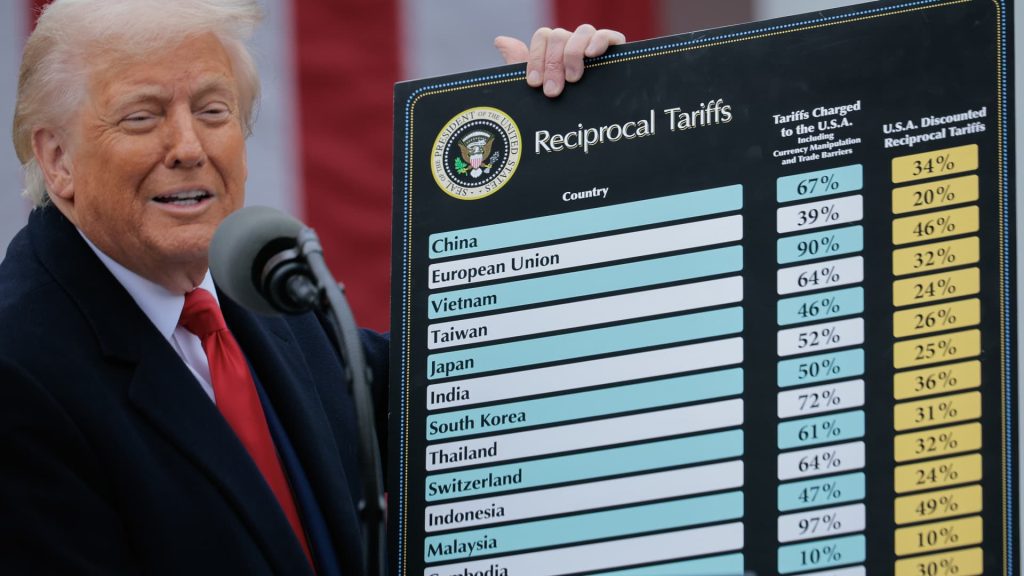U.S. President Donald Trump speaks during a “Make America Wealthy Again” trade announcement event in the Rose Garden at the White House on April 2, 2025 in Washington, DC.
Chip Somodevilla | Getty Images
Markets have turned their sights on how U.S. President Donald Trump’s administration arrived at the figures behind the sweeping tariffs on U.S. imports declared Wednesday, which sent global financial markets tumbling and sparked concerns worldwide.
Trump and the White House shared a series of charts on social media detailing the tariff rates they say other countries impose on the U.S. Those purported rates include the countries’ “Currency Manipulation and Trade Barriers.”
An adjacent column shows the new U.S. tariff rates on each country, as well as the European Union.
Chart of reciprocal tariffs.
Courtesy: Donald Trump via Truth Social
Those rates are, in most cases, roughly half of what the Trump administration claims each country has “charged” the U.S. CNBC could not independently verify the U.S. administration’s data on these duties.
It didn’t take long for market observers to try and reverse engineer the formula — to confusing results. Many, including journalist and author James Surowiecki, said the U.S. appeared to have divided the trade deficit by imports from a given country to arrive at tariff rates for individual countries.
Such methodology doesn’t necessarily align with the conventional approach to calculate tariffs and would imply the U.S. would have only looked at the trade deficit in goods and ignored trade in services.
For instance, the U.S. claims that China charges a tariff of 67%. The U.S. ran a deficit of $295.4 billion with China in 2024, while imported goods were worth $438.9 billion, according to official data. When you divide $295.4 billion by $438.9 billion, the result is 67%! The same math checks out for Vietnam.
“The formula is about trade imbalances with the U.S. rather than reciprocal tariffs in the sense of tariff level or non-tariff level distortions. This makes it very difficult for Asian, particularly the poorer Asian countries, to meet US demand to reduce tariffs in the short-term as the benchmark is buying more American goods than they export to the U.S., ” according to Trinh Nguyen, senior economist of emerging Asia at Natixis.
“Given that U.S. goods are much more expensive, and the purchasing power is lower for countries targeted with the highest levels of tariffs, such option is not optimal. Vietnam, for example, stands out in having the 4th largest trade surplus with the U.S., and has already lowered tariffs versus the U.S. ahead of tariff announcement without any reprieve,” Nguyen said.
The U.S. also appeared to have applied a 10% levy for regions where it is running a trade surplus.

The Office of the U.S. Trade Representative laid out its approach on its website, which appeared somewhat similar to what cyber sleuths had already figured out, barring a few differences.
The U.S.T.R. also included estimates for the elasticity of imports to import prices—in other words, how sensitive demand for foreign goods is to prices—and the passthrough of higher tariffs into higher prices of imported goods.
“While individually computing the trade deficit effects of tens of thousands of tariff, regulatory, tax and other policies in each country is complex, if not impossible, their combined effects can be proxied by computing the tariff level consistent with driving bilateral trade deficits to zero. If trade deficits are persistent because of tariff and non-tariff policies and fundamentals, then the tariff rate consistent with offsetting these policies and fundamentals is reciprocal and fair,” the website reads.
This screenshot of the U.S.T.R. webpage shows the methodology and formula that was used in greater detail:
A screenshot from the website of the Office of the United States Trade Representative.
Some analysts acknowledged that the U.S. government’s methodology could give it more wiggle room to reach an agreement.
“All I can say is that the opaqueness surrounding the tariff numbers may add some flexibility in making deals, but it could come at a cost to US credibility,” according to Rob Subbaraman, head of global macro research at Nomura.
— CNBC’s Kevin Breuninger contributed to this piece.


